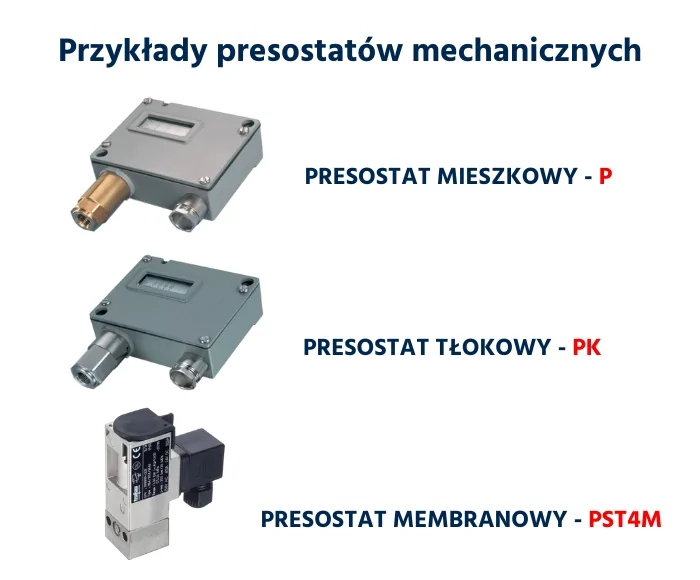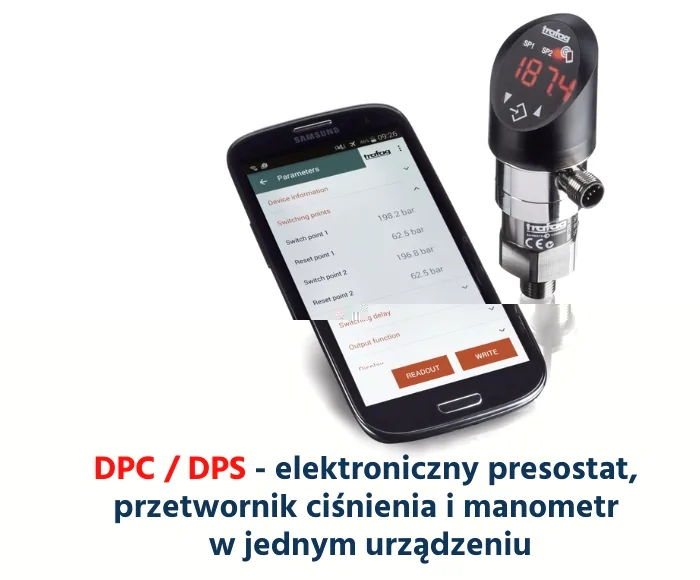24.07.2024
Pressure switch, pressure transmitter and pressure gauge are three different devices used in pressure measurement and control systems. Each of them has different functions. The pressure switch is used to monitor the pressure in the system and automatically turn devices on or off depending on the set pressure thresholds. A pressure transducer is a device that converts physical pressure into an electrical signal that can be sent to control or monitoring systems. The pressure gauge is used to directly read the pressure by the operator.
A mechanical pressure switch works by detecting changes in system pressure and mechanically switching electrical contacts in response to these changes. Depending on the pressure in the system, mechanical bellows, diaphragm or piston pressure switches are used. Bellows pressure switches are very sensitive. They are used for smaller pressure ranges (-0.6…3.4 to 0…100 bar). Piston and diaphragm pressure switches are more resistant to overloads than bellows pressure switches. Piston pressure switches are ideal for working at high pressure in hydraulic systems (1...10 to 60...600 bar). Membrane pressure switches are the ideal solution for liquids, steam and gases.
The principle of operation of mechanical piston, diaphragm and bellows pressure switches is the same. An actuator in the form of a diaphragm, piston or bellows moves in response to changing pressure. The increase in pressure causes the actuator to move in the opposite direction to the action of the spring. The pressure drop causes the spring to return the actuator to its original position. When the pressure reaches the set threshold, the actuator movement is large enough to press on the switch mechanism, causing it to switch (close or open the electrical contacts). The user can adjust the spring tension using the adjustment screw. Changing the spring tension changes the pressure threshold at which switching occurs. When the system pressure drops below the set threshold, the spring returns the actuator to its original position, which causes the switch to return to its original state (open or closed contacts).
Unlike electronic pressure switches, mechanical pressure switches do not require external power, which makes them more independent and easier to install in places without access to a power source.

Thanks to the possibility of adjusting parameters and precision of measurements, the electronic pressure switch is widely used in various industries, providing reliable control over the pressure in systems. The principle of operation of the electronic pressure switch is based on pressure measurement using a sensor and appropriate interpretation of this measurement by the electronics. The electronic pressure switch consists of a pressure sensor that measures the pressure in the system and an electronic module that processes the signal from the sensor and takes appropriate actions based on it. When the pressure reaches a set limit, the electronic module can start or stop other devices or processes in the system. Compared to traditional mechanical pressure switches, electronic pressure switches offer greater measurement precision, more precise setting of switching points and the ability to set a very small hysteresis.
Poltraf's offer includes electronic pressure switches from the Swiss manufacturer Trafag: DPC/DPS and NAT.
DPC and DPS are the perfect combination of an electronic pressure switch, pressure transmitter and pressure gauge in one device. Configuration of these pressure switches is possible using buttons or a smartphone application with NFC (Android) or physically using buttons on the display. The built-in memory allows you to record over 3,500 measurements and create reports that can be easily sent by e-mail. Ease of use as well as a wide range of options make the DPS and DPS valuable pressure measurement and control devices in applications where precision, reliability and long-term stability are required.
The Trafag NAT electronic pressure switch does not have a display. It is characterized by high accuracy and repeatability.
All the above electronic pressure switches (DPS, DPS and NAT) have 2 switchable contacts.
04.03.2024
The EPI pressure transmitter from the Swiss manufacturer Trafag will be used in many industries, including the water supply and sewage industry and heating. The EPI pressure transducer is characterized by very good durability. It is equipped with a sensor made using thin film technology on steel, which, combined with the ASICTX processor, covers a wide temperature range up to 125°C. Now, a new, lower price applies for EPI with a pressure range of 0...6, 0...10 and 0...16 bar!

14.03.2025
On April 8-10, 2025, over 100 exhibitors from 8 countries will meet at the Poznań International Fair, presenting the latest technologies and innovative solutions supporting the energy transformation process. There will be no shortage of debates, presentations and networking at the highest level. Poltraf will be one of the participants of this event.

10.10.2024
The Poltraf FLOW MEASUREMENT: CHALLENGES – TECHNOLOGIES – SOLUTIONS conference was held on October 2-4. Available technologies, advantages and comments regarding individual solutions were presented by our partners: Comac Cal, Systec Controls and In-Situ (MACE). The conference was also an opportunity to celebrate the 30th anniversary of our company, which is why this year we met in Gdańsk, where Poltraf has been based since the very beginning of its operations.

We are a representative and distributor in Poland of the following brands: